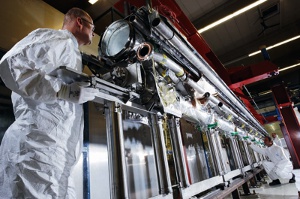
DESY's Building 28 is the place where many superconducting ILC-style accelerator modules were born. The construction and assembly of the 101 modules for the European XFEL accelerator is an international endeavour, so DESY scientists and technicians have formed a mobile training team that educates people about the firms and institutes involved in giving birth to accelerator modules. In the picture the technicians couple the string of eight niobium cavities with the so-called cold mass, which carries the string. After the heat shields are mounted, a piece of high-tech art is mounted in the familiar yellow tanks. Image: DESY
The European XFEL X-ray laser in Hamburg, Germany, will use accelerator modules of the newest generation. These high-tech devices are operated using superconducting technology at temperatures similar to those in outer space. The concept was developed and brought to practical application by the international TESLA collaboration, led by DESY.
Meanwhile, the construction of the accelerator complex for the European XFEL is in full swing and the participating institutes and companies are preparing the series production of the 101 modules, each of which contains eight niobium cavities. The manufacture and assembly of these high-tech components are extremely complex. The highest precision and quality are required to ensure that the electron beam can later be accelerated to the targeted energy of 17.5 gigaelectronvolts.
DESY is coordinating the international consortium of institutes that participate in the construction of the European XFEL accelerator. DESY experts impart their knowledge to optimise the production of accelerator modules at the various manufacturing sites all over the world. Thus one of the already-finished modules has recently been completely taken apart to be reassembled again at CEA/Irfu in Saclay, France, as part of a training unit. All the modules for the European XFEL will later be assembled, measured and adjusted at Irfu – a highly complicated affair for which a simple blueprint is insufficient and that requires a successful technology transfer.
If the assembly is successful, the module will be transported back to DESY where it will have to pass a series of tests in the hall of the specially erected Accelerator Module Test Facility. The AMTF hall is where all the resonators and accelerator modules from the series production will later be checked under operating conditions before being installed in the European XFEL tunnel. Polish experts are responsible for these tests – their work is one of the so-called in-kind contributions by the partners participating in the European XFEL. Here too, the experience of DESY is being passed on as part of the test of the first modules.
Overall, seven institutes from different countries are involved in the production of the accelerator modules. Besides DESY, these are CEA/Irfu, CNRS/LAL in Orsay, France, INFN Milano in Italy, IPJ Swierk in Poland, CIEMAT Madrid in Spain and BINP Novosibirsk in Russia. The rest of the 16 institutions of the international Accelerator Consortium participate in the remaining accelerator sections.
Before a module is finally in place in the accelerator tunnel, it goes through a long journey. This begins with the niobium sheets, which are provided by manufacturers from Austria, China and Japan. From these sheets, the companies Research Instruments in Bergisch-Gladbach, Germany, and Zanon in Italy will form the superconducting accelerating structures, the cavities. The series delivery is to start in early summer 2012. Up to eight cavities per week will then be delivered to DESY and thoroughly tested before travelling on to Irfu where the modules are assembled. These yellow tubes are manufactured in Italy and China and act like giant thermos bottles, shielding the cold of space inside from the outside air. In addition to the cavities, they will also contain quadrupole magnets from Spain and radiofrequency couplers from France. The finished modules will then travel back to DESY to be tested in the AMTF hall and prepared for final installation in the accelerator tunnel.
During the production phase, one module per week will find its place in the tunnel – it will thus take two years to install all 101 modules of the accelerator. What now arises between Hamburg-Bahrenfeld and Schenefeld is not only the “light of the future,” but also a real prime example of European and international cooperation.

Recent Comments